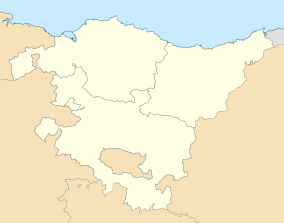Salburua facts for kids
Quick facts for kids Salburua |
|
|---|---|

A view of one of the lagoons
|
|
| Location | Basque Country, Spain |
| Nearest city | Vitoria-Gasteiz |
| Area | 160 hectares (400 acres) |
| Established | 1992 |
| Visitors | 125000 (in 2002) |
| Governing body | Vitoria-Gasteiz City Council |
| Salburua, website of the Vitoria-Gasteiz City Council | |
| Designated: | 24 October 2002 |
| Reference #: | 1263 |
| Area: | 174 ha (430 acres) |
|
Invalid designation
|
|
| Designated: | June 2015 |
| Reference #: | ES2110014 |
| Area: | 2.17 km2 (0.84 sq mi) |
Salburua is a special wetland area located just outside the city of Vitoria-Gasteiz in the Basque Country, Spain. This important natural space is part of the city's "green belt." It features beautiful lakes, open meadows, and old oak forests.
For a long time, Salburua was drained to create farmland. However, starting in 1994, a big effort began to restore it. Now, Salburua is recognized as a Ramsar Wetland of International Importance. Experts call it "the Basque country's most valuable area of wetland."
Contents
History of Salburua: From Farmland to Wetland
Before 1857, Salburua was a natural wetland with at least three lakes: Betoño, Larregana, and Arcaute. People in the Basque Country knew it for good grazing, hunting, and fishing. An oak forest grew around Arcaute lake.
Why Were the Lakes Drained?
In 1857, people started draining the lakes and cutting down the forests. They wanted to turn the land into valuable farms. This continued into the 20th century. Betoño, the last lake, was drained during this time.
How Salburua Was Restored
Work to bring back the old landscape began in 1994. Back then, only a small forest and a tiny wet area near Betoño remained. Only a few animals and plants from the original wetland survived. The area also suffered from poaching, slums, and waste.
Ecological restoration started by reversing the drainage of Lake Betoño. In 1998, a dam was built to help this process. Thanks to these efforts, over 180 hectares (440 acres) of land has been recovered. During times of heavy rain, about 60 hectares (150 acres) of this area is covered by water.
Protecting the City from Floods
The restoration of Salburua also helps protect Vitoria-Gasteiz from floods. The lagoons and ponds act like a natural sponge, holding excess water. Besides bringing nature back, new walkways, paths, and bird hides have been added for visitors.
Amazing Animals and Plants of Salburua
Salburua is home to many different kinds of plants and animals. It is a very important place for biodiversity. However, new invasive species are a threat to the native plants and animals here.
Plants of Salburua
While the animals are often the most noticeable, Salburua also has many interesting plants. Wetland species are especially common. Many of these plants have returned since the wetlands were restored. There are about 35 different species, including marshmallow, aconite, sedges, and orchids.
Animals of Salburua
Most of the wildlife in Salburua is wild. A group of deer was brought in to help control the plants. Salburua has one of the most important communities of carabid beetles in the Iberian Peninsula. It also has many different amphibians and reptiles.
Thousands of birds visit Salburua because it is on their migration routes. Some birds stay through the winter, and others even choose these ponds for breeding. The European mink, one of the world's most endangered carnivores, has been reintroduced here.
Protecting Endangered Species
The INBIOS Project works to help threatened species in Salburua. This includes bats, sand martins, wading birds, herons, and otters. The project also improves habitats like aquatic plants and pond edges. They fight against invasive animals, fish, and American freshwater crayfish. One goal is to reintroduce the European mink into rivers in northern Spain.
Salburua and the City: Urban Development
The Salburua wetlands are next to a large residential area of Vitoria-Gasteiz. This area was still being built in 2012. The northern part has tall, eco-friendly buildings and apartment blocks. The old runway of the city airport, which was in the middle of this development, is now an avenue.
This area has about 7,000 residents. The Santo Tomas district is still under construction. It will eventually be home to about 16,000 people. The "Gateway of Arkay" will connect to nearby towns like Elorriaga and Arkay. Its development started in mid-2010.
See also
 In Spanish: Parque de Salburua para niños
In Spanish: Parque de Salburua para niños





